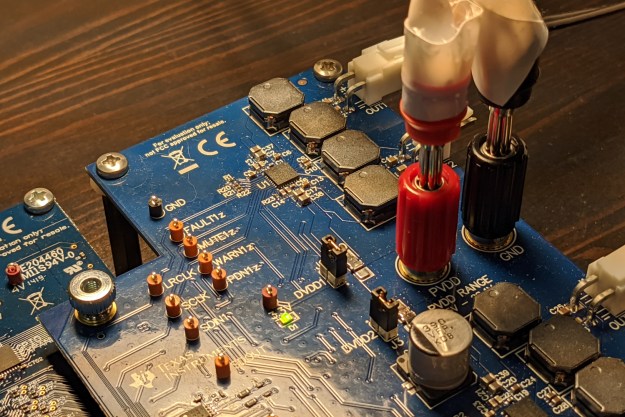When it comes to listening to music on the go, audio enthusiasts don’t really get too many options. Unlike home audio systems, there are no pre-amps, amps, equalizers, or even wires to pick out – just a player and a pair of headphones. And if you’re looking for anything to tweak that sound a little, well, unless you want to play with the built-in presets on your player, you’re out of luck.
Or maybe not. For the audiophile who insists on taking his hi-fi experience mobile, a company known as Tensions Labs has cooked up a digital earphone amplifier – the first on the market – called the EAP03.
Image Courtesy of Tension Labs (LCD screen sold seperately)
Skeptics might be a little confused by this concept. After all, the point of an amplifier is to increase volume, and as anyone who has cranked an MP3 player to its loudest setting knows, most of them are capable of delivering enough juice out of the box – but not always. While stock headphones are usually efficient enough to deal with the low power output of a basic MP3 player, high quality headphones often trade efficiency for their quality, producing less volume from the same strength signal, and necessitating an amp.
The EAP03 fills the void for audiophiles who prefer power-hungry headphones by offering pocket-sized amplification. At just over three inches long, two inches wide and weighing 55 grams, it’s similar in size and weight to many MP3 players, and could fit right alongside one in a pocket. It uses a small monochrome LCD screen as a display, along with color indicator lights and a simple volume control wheel. Power is provided by an internal lithium-ion battery that should last for seven to eight hours.
Of course, all of that extra audio grunt can make it tempting to take the volume a little too high, which is why the EAP03 includes a hearing level monitor. By combining data about its signal output with data about the sensitivity of your headphones, the EAP03 can actually calculate how loud your music is in real time, and tell you how long you can safely listen to it without hearing damage. For live music aficionados, the built-in microphone also measures ambient noise, letting you know just how long you can stand in front of that speaker stack before things get ugly.
Although it’s billed as an amplifier, the EAP03 might just as well be called a processor, since it has a range of sound-bending options to play with. For starters, there’s a multi-band equalizer. Users can adjust bass, midrange and treble levels in 3 dB increments, and also change which frequencies are covered by each filter. An option known as 3DX mimics stereo speakers by creating controlled mixing between right and left channels, similar to the way sound from right and left speakers blend in a room. The built-in mic can also be used to provide ambient noise through the headphones in order to prevent the sealed-in feeling earbuds create.
The casual iPod crowd probably won’t salivate too much over these features, nor will they appreciate the extra bulk of carrying the EAP03 around with them. But for audio purists who aren’t afraid to take a little equipment on the road, the EAP03 could be a handy piece of gear. At $179 USD, it’s as much or more than many standalone MP3 players, but as with any piece of audiophile gear, price will likely not be a deterrent for its intended audience. You can find more information at TensionLabs.com.
Editors' Recommendations
- Tiger steaks and lion burgers: Lab-grown exotic animal meat is on the way
- No cows required: This startup’s lab-grown milk is identical to the real thing
- The 50-year old Silicon Valley lab that practically invented modern computing
- Researchers build the world’s most sophisticated lab model of the human body
- Launching little: Inside Rocket Lab’s ingenious plan to democratize space



